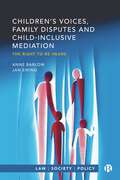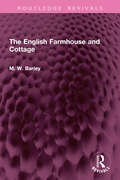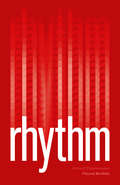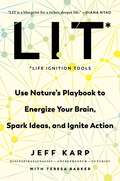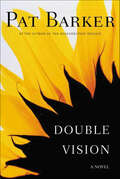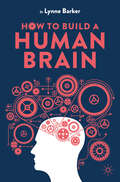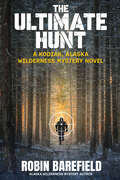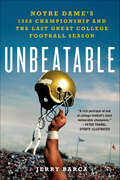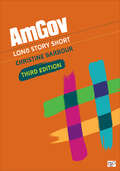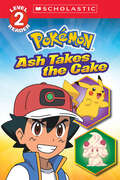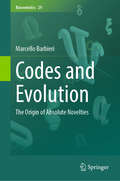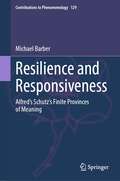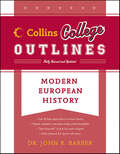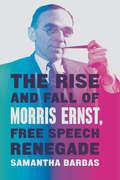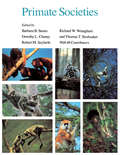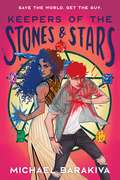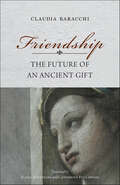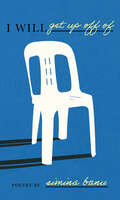- Table View
- List View
Unified Protocol for Transdiagnostic Treatment of Emotional Disorders: Workbook (Treatments That Work)
by David H. BarlowLeading therapists and researchers have come to understand that many psychological disorders share common features and respond to common therapeutic treatments. This deepened understanding of the nature of psychological disorders, their causes, and their symptoms has led to the development of new, comprehensive treatment programs that are effective for whole classes of disorders. Unified Protocol for Transdiagnostic Treatment of Emotional Disorders is one such program. <P><P>Designed for individuals suffering from emotional disorders, including panic disorder, social anxiety disorder, generalized anxiety disorder, posttraumatic stress disorder, obsessive compulsive disorder, and depression, this program focuses on helping you to better understand your emotions and identify what you're doing in your responses to them that may be making things worse. Throughout the course of treatment you will learn different strategies and techniques for managing your emotional experiences and the symptoms of your disorder. You will learn how to monitor your feelings, thoughts, and behaviors; confront uncomfortable emotions; and learn more effective ways of coping with your experiences. By proactively practicing the skills presented in this book-and completing the exercises, homework assignments and self-assessment quizzes provided in each chapter, you will address your problems in a comprehensive and effective way so you can regulate your emotional experiences and return to living a happy and functional life.
Children’s Voices, Family Disputes and Child-Inclusive Mediation: The Right to Be Heard (Law, Society, Policy)
by Anne Barlow Jan EwingePDF and ePUB available open access under CC-BY-NC-ND licence. Recent legislative changes in England and Wales have eroded children’s ability to exercise their article 12 UNCRC rights to information, consultation and representation when parents separate. However, children’s voices may be heard through child-inclusive mediation (CIM). Considered from a children’s rights perspective, this book provides a critical socio-legal account of CIM practice. It draws on in-depth interviews with relationship professionals, mediators, parents and children, to consider the experiences, risks and benefits of CIM. It investigates obstacles to greater uptake of CIM and its role in improving children’s wellbeing and agency. Exploring the culture and practice changes necessary for a more routine application of CIM, the book demonstrates how reconceptualising CIM through a children’s rights framework could help to address barriers and improve outcomes for children.
The English Farmhouse and Cottage (Routledge Revivals)
by M. W. BarleyFirst published in 1961, The English Farmhouse and Cottage brings together the evidence collected by those who have studied vanished buildings by excavation, and also examined surviving houses with a gentler instrument, the measuring tape. A change is taking place in the attitude towards the old buildings of the countryside. Into the place of the sentimentalist in search of the picturesque and the architect looking for a style have stepped the local historian and the archaeologist. Mr. Barley has built up a picture of the English countryman and his housing needs. He is concerned particularly with the sixteenth and seventeenth centuries since they were the most formative period in the evolution of the modern house.This book is an essential tool in the hands of those who wish to pursue, whether as tourists or as students, an important and fascinating aspect of the history of Rural England.
Rhythm: Form & Dispossession
by Vincent BarlettaMore than the persistent beat of a song or the structural frame of poetry, rhythm is a deeply imbedded force that drives our world and is also a central component of the condition of human existence. It’s the pulse of the body, a power that orders matter, a strange and natural force that flows through us. Virginia Woolf describes it as a “wave in the mind” that carries us, something we can no more escape than we could stop our hearts from beating. Vincent Barletta explores rhythm through three historical moments, each addressing it as a phenomenon that transcends poetry, aesthetics, and even temporality. He reveals rhythm to be a power that holds us in place, dispossesses us, and shapes the foundations of our world. In these moments, Barletta encounters rhythm as a primordial and physical binding force that establishes order and form in the ancient world, as the anatomy of lived experience in early modern Europe, and as a subject of aesthetic and ethical questioning in the twentieth century. A wide-ranging book covering a period spanning two millennia and texts from over ten languages, Rhythm will expand the conversation around this complex and powerful phenomenon.
LIT: Use Nature's Playbook to Energize Your Brain, Spark Ideas, and Ignite Action
by Teresa Barker Jeff KarpSelected as a must-read by the curators of the Next Big Idea Book Club, including Daniel Pink, Susan Cain, Malcolm Gladwell, and Adam Grant“In this illuminating guide, Jeff Karp illustrates how we can break free from the routines that limit our thinking. LIT is an essential toolkit for converting intentions into actions that matter.” —Daniel H. Pink, #1 New York Times bestselling author“Don’t we all want to tap our innermost talents of creativity, the full power of our good brains?. . . LIT is a blueprint for a richer, deeper life." —Diana Nyad“Jeff Karp’s much-needed book provides a spark and helps us light ourselves up from within — while lighting up the world around us, bringing joy and creativity to all aspects of our lives.” —Arianna HuffingtonRadically simple experimental tools to help anyone tap into a high-energy brain state to fire up innovative potential and shape their lives with intention—by the founder of a Harvard biomedical engineering innovation lab.In an age of convenience and information overload, it’s easy to go through the motions, pressured, distracted, and seeking instant gratification rather than harnessing our potential for meaningful and impactful lives. In LIT, Jeff Karp, Ph.D., professor at Brigham and Women’s Hospital, Harvard Medical School, and biotech innovator, helps us look to nature as a vital source of humankind’s best wisdom, most inspired action, and greatest good. Diagnosed with learning differences at a young age, he persisted through nearly insurmountable struggles with support from his mom in developing ways to achieve hyper-awareness and maximize decisions based on his curiosity, passion, creativity, and connection to nature. He evolved these approaches into LIT (Life Ignition Tools) —and road-tested these tools daily in his own personal life and with his lab team to innovate medical discoveries inspired by the “problem solving” process they find throughout the natural world.LIT teaches us to:turn inward and connect with what is truly important to usturn outward to act on that, connecting with others and different ways of knowingquestion assumptions—break out of habitual thinking and other patterns to discover what really serves you bestexplore, experiment, and discover fresh approaches to old challengesDr. Karp also shares insights from some of the world’s most accomplished people, including Nobel Prize winners, the founder of an Indigenous wellness center, a visionary photographer, a social justice activist, a five-time US memory champion, an Olympic medalist, and a neurosurgeon who founded a center for compassion, as well as professors, inventors, entrepreneurs, CEOs, and members of his laboratory.Using Dr. Karp’s principles, anyone can redirect their lives with energy, focus, creativity, motivation, intention, and impact. Learning to be lit is the ultimate renewable energy and is accessible to everyone, anytime, wherever you are.
Double Vision: A Novel
by Pat BarkerDouble Vision from Pat Barker, a gripping novel about the effects of violence on the journalists and artists who have dedicated themselves to representing itIn the aftermath of September 11, 2001, reeling from the effects of reporting from New York City, two British journalists, a writer, Stephen Sharkey, and a photographer, Ben Frobisher, part ways. Stephen, facing the almost simultaneous discovery that his wife is having an affair, returns to England shattered; he divorces and quits his job. Ben returns to his vocation. He follows the war on terror to Afghanistan and is killed. Stephen retreats to a cottage in the country to write a book about violence, and what he sees as the reporting journalist's or photographer's complicity in it; it is a book that will build in large part on Ben's writing and photography. Ben's widow, Kate, a sculptor, lives nearby, and as she and Stephen learn about each other their world speedily shrinks, in pleasing but also disturbing ways; Stephen's maid, with whom he has begun an affair, was once lovers with Kate's new studio assistant, an odd local man named Peter. As these connections become clear, Peter's strange behavior around Stephen and Kate begins to take on threatening implications. The sinister events that take place in this small town, so far from the theaters of war Stephen has retreated from, will force him to act instinctively, violently, and to face his most painful revelations about himself.
How to Build a Human Brain
by Lynne BarkerHow to Build a Human Brain takes a developmental approach to understanding brain structure and function. It guides readers through the evolution of the human brain, from its cellular building blocks, up to hind brain structures and functions, and through to neocortex and associated functions. In doing so, it enables students to develop a comprehensive knowledge of the relationship between brain networks and functions, neural underpinnings of functional problems seen after neuropathology, and neuroanatomy.Written in an engaging style, each chapter follows a blueprint format with subsections on issues like 'damage and repair' and 'faulty wiring' as the brain is ‘built’ across the course of the book. The author includes illustrative case studies and entertaining fast fact boxes to highlight the real-word relevance of each brain structure being examined. This textbook offers an accessible reference for students of neuroscience, cognitive neuroscience, neuropsychology,and biological psychology.
Crime Prevention: Programs, Policies, and Practices
by Steven E. Barkan Michael A. RocqueIn Crime Prevention: Programs, Policies, and Practices, criminologists Steven E. Barkan and Michael Rocque present a well-rounded exploration of evidence-based policies, programs, and practices. Grounded in criminological theory and emphasizing the social, psychological, and biological roots of crime, this text presents current research, perspectives, and examples that capture the key crime prevention concepts students should understand, including the public health model for crime prevention. Highlighting the importance of applying theory to real-world solutions, the authors′ discussion of crime prevention strategies integrates theory and practice throughout the text.
Crime Prevention: Programs, Policies, and Practices
by Steven E. Barkan Michael A. RocqueIn Crime Prevention: Programs, Policies, and Practices, criminologists Steven E. Barkan and Michael Rocque present a well-rounded exploration of evidence-based policies, programs, and practices. Grounded in criminological theory and emphasizing the social, psychological, and biological roots of crime, this text presents current research, perspectives, and examples that capture the key crime prevention concepts students should understand, including the public health model for crime prevention. Highlighting the importance of applying theory to real-world solutions, the authors′ discussion of crime prevention strategies integrates theory and practice throughout the text.
The Ultimate Hunt: A Kodiak, Alaska Wilderness Mystery Novel
by Robin BarefieldWhen the daughter of a US senator disappears from the center of Kodiak, Alaska, in the middle of the day, FBI agent Nick Morgan arrives to assist police detective Maureen Horner and Alaska State Trooper Dan Patterson with the investigation. Soon, the officers realize that other young people have vanished from the area as well, and they can find no evidence or eyewitnesses to explain the disappearances. Meanwhile, bored pilot Steve Larson spends his evenings sitting on the back deck of his floatplane air charter service while he recovers from a debilitating illness. He watches a plane land after dark and sees two men escort a seemingly incapacitated woman to the plane and push her into the rear seat. When the same thing happens a few days later, Steve wonders if he's imagining things or if these men are kidnapping people. He calls marine biologist and amateur detective Jane Marcus and asks her to sit with him the next time the plane arrives. Jane agrees with Steve: these men are drugging and transporting people against their will. But where are they taking them, and why? Jane's curiosity leads her into a nightmare worse than anything she could imagine. As law enforcement officers work to find who's behind the kidnappings and where the abductors have taken the victims, Jane fights to survive the monsters chasing her in the ultimate hunt.
Unbeatable: Notre Dame's 1988 Championship and the Last Great College Football Season
by Jerry BarcaPerhaps the best undefeated team in the history of college football—Unbeatable presents the dramatic true story of the 1988 Notre Dame Fighting Irish and their incredible unbeaten season.Unbeatable is the first book to tell the complete story of the incredible 1988 season that brought the fledgling Fighting Irish back to the top of college sports in what many consider to be the greatest unbeaten season of college football ever played. With a completely unlikely but forever memorable cast of characters—including the slight, lisping coach Lou Holtz; the star quarterback, Tony Rice; five foot nothing Asian kicker, Reggie Ho; NFL-bound Ricky Watters; and a crazed and ferocious defensive line, among others—Notre Dame whipped millions of fans into a frenzy. This roller coaster season of football includes the infamous Catholics vs. Convicts game (Notre Dame vs. Jimmy Johnson's #1 ranked Miami Hurricanes). The two teams were undefeated when they met at Notre Dame Stadium, with the Irish winning in the final seconds by a final score of 31-30.With original reporting and interviews with everyone from the players to the coaches, detailed research, and access to the Notre Dame archives, Jerry Barca tells a gripping story of an unbelievable season and the players who would become legends. More than a Notre Dame book, Unbeatable is a compelling narrative of one of the most incredible sports stories of the last century—the unlikely tale of an underdog team coming together and making history.
AmGov: Long Story Short
by Christine BarbourAll the fundamentals. No fluff. Learn more with less! AmGov: Long Story Short helps students learn the nuts and bolts of American Government. Unlike competitors, this bestseller responds to the need for quick studying and skimming with ten succinct chapters that make it easy to read, revisit, and return to content quickly. Reading aids like bullets, annotations, and arrows walk students through important facts and break up the material in short, engaging bites of information. Though brief, the Third Edition of this core book is still robust and current enough to provide everything that students need to be successful in their American Government course. Whether for the on-the-go student who doesn’t have time to read and digest a lengthy chapter, or for the instructor who wants a book that will stay out of their way and leave room for plenty of supplementary reading and activities, AmGov provides a perfectly simplified foundation for a successful American Government course. This title is accompanied by a complete teaching and learning package. Contact your SAGE representative to request a demo. Learning Platform / Courseware SAGE Vantage is an intuitive learning platform that integrates quality SAGE textbook content with assignable multimedia activities and auto-graded assessments to drive student engagement and ensure accountability. Unparalleled in its ease of use and built for dynamic teaching and learning, Vantage offers customizable LMS integration and best-in-class support. It’s a learning platform you, and your students, will actually love. Learn more. Assignable Video with Assessment Assignable video (available in SAGE Vantage) is tied to learning objectives and curated exclusively for this text to bring concepts to life. Watch a sample video now. LMS Cartridge: Import this title’s instructor resources into your school’s learning management system (LMS) and save time. Don’t use an LMS? You can still access all of the same online resources for this title via the password-protected Instructor Resource Site. Learn more.
AmGov: Long Story Short
by Christine BarbourAll the fundamentals. No fluff. Learn more with less! AmGov: Long Story Short helps students learn the nuts and bolts of American Government. Unlike competitors, this bestseller responds to the need for quick studying and skimming with ten succinct chapters that make it easy to read, revisit, and return to content quickly. Reading aids like bullets, annotations, and arrows walk students through important facts and break up the material in short, engaging bites of information. Though brief, the Third Edition of this core book is still robust and current enough to provide everything that students need to be successful in their American Government course. Whether for the on-the-go student who doesn’t have time to read and digest a lengthy chapter, or for the instructor who wants a book that will stay out of their way and leave room for plenty of supplementary reading and activities, AmGov provides a perfectly simplified foundation for a successful American Government course. This title is accompanied by a complete teaching and learning package. Contact your SAGE representative to request a demo. Learning Platform / Courseware SAGE Vantage is an intuitive learning platform that integrates quality SAGE textbook content with assignable multimedia activities and auto-graded assessments to drive student engagement and ensure accountability. Unparalleled in its ease of use and built for dynamic teaching and learning, Vantage offers customizable LMS integration and best-in-class support. It’s a learning platform you, and your students, will actually love. Learn more. Assignable Video with Assessment Assignable video (available in SAGE Vantage) is tied to learning objectives and curated exclusively for this text to bring concepts to life. Watch a sample video now. LMS Cartridge: Import this title’s instructor resources into your school’s learning management system (LMS) and save time. Don’t use an LMS? You can still access all of the same online resources for this title via the password-protected Instructor Resource Site. Learn more.
Ash Takes the Cake (Scholastic Reader, Level 2)
by Maria S. BarboKids can practice their reading skills with Pokémon in this fun Level 2 Reader.Join Ash and Pikachu on a sweet adventure in this Level 2 Reader! This easy-to-read book features a cake decorating contest where Trainers partners with Alcremie, the Cream Pokémon—and a battle where Pikachu eats more cream than it can handle!With full-color illustrations on every page, this exciting but simple story is based on an episode from the hit animated TV series.
Codes and Evolution: The Origin of Absolute Novelties (Biosemiotics #29)
by Marcello BarbieriThis text builds upon the over 1500 papers published in peer-reviewed journals revealing that there are more than 200 biological codes in living systems. The author claims this experimental fact is bound to change biology forever. This book shows how this very discovery reveals that coding is a new mechanism of life, just as the discovery of electromagnetism revealed the existence of a new physical force in the universe. The existence of many biological codes, furthermore, Barbieri argues, is one of those experimental facts that have extraordinary theoretical consequences. It implies that coding is not only a mechanism that constantly operates in all living systems, but also a mechanism of evolution, more precisely a mechanism that gave origin to the absolute novelties of the history of life. This amounts to saying that evolution took place by two distinct mechanisms, by natural selection and by natural conventions, two mechanisms that are fundamentally different because natural selection is the result of copying and deals with information whereas natural conventions are the result of coding and deal with meaning. This volume appeals to students and researchers working in the fields of semiotics, philosophy, biology and mathematics.
The Marlowe Papers: A Novel
by Ros BarberWinner of the 2013 Desmond Elliott PrizeLonglisted for the 2013 Women's Prize for FictionYou're the author of the greatest plays of all time.But nobody knows.And if it gets out, you're dead.On May 30, 1593, a celebrated young playwright was killed in a tavern brawl in London. That, at least, was the official version. Now Christopher Marlowe reveals the truth: that his "death" was an elaborate ruse to avoid a conviction of heresy; that he was spirited across the English Channel to live on in lonely exile; that he continued to write plays and poetry, hiding behind the name of a colorless man from Stratford—one William Shakespeare.With the grip of a thriller and the emotional force of a sonnet, this remarkable novel in verse gives voice to a man who was brilliant, passionate, and mercurial. A cobbler's son who counted nobles among his friends, a spy in the Queen's service, a fickle lover and a declared religious skeptic, Christopher Marlowe always courted trouble. In this memoir, love letter, confession, and settling of accounts, Ros Barber brings Christopher Marlowe and his era to vivid life in The Marlowe Papers.
Resilience and Responsiveness: Alfred’s Schutz’s Finite Provinces of Meaning (Contributions to Phenomenology #129)
by Michael BarberThis book extends Alfred Schutz’s “On Multiple Realities” by describing the provinces of meaning of play, music, religious ritual, and African-American folkloric humor. Throughout these provinces, the author traces two themes: resilience and responsiveness. In resilience, individuals or communities run up against obstacles, imposed relevances, which they come to terms with, or give meaning to (in phenomenological parlance), by modifying, evading, overcoming, or accepting them. Responsiveness emerges from Schutz’s idea of making music together, which the author takes further by analyzing the mimetic encounter with the other and the asymmetries in listening to music, and, especially, by showing how the features of the cognitive style of music as a province of meaning affect sociality, disposing us to be more vulnerable and attentive to each other’s non-conceptual, musical meanings. This text appeals to upper-level undergraduate students and graduate students as well as to faculty in philosophy.
Modern European History (Collins College Outlines)
by John R. BarberThe Age of Modern Europe; The Industrial Revolution; The Ancien Regime and Its Critics; The Despots and the High Enlightenment; The French Revolution and the Reign of Terror; The French Revolution and the Napoleonic Empire; The Attempt to Restore the Acien Regime; The Age of European Revolution; The New Nationalism; The Industrial Nation States; The Industrializing States; The Culture of Industrial Europe; The Great War and the Russian Revolution; The Formation of the Soviet Union; The Rise of Fascism; The European Democracies; The Second World War; Cold War Europe; Eastern Europe since 1953; The Cold Wars and After; Western Europe and the European Community since the 1950's; Modern and Ultra-Modern Europe in the 1990's.Also includes Chronology of History, Maps, Charts, Tables, Full Index, and Bibliography.
White Poverty: How Exposing Myths About Race and Class Can Reconstruct American Democracy
by William J. Barber IIA generational work with far-ranging social and political implications, White Poverty, promises to be one of the most influential books in recent years. One of the most pernicious and persistent myths in the United States is the association of Black skin with poverty. Though there are forty million more poor white people than Black people, most Americans, both Republicans and Democrats, continue to think of poverty—along with issues like welfare, unemployment, and food stamps—as solely a Black problem. Why is this so? What are the historical causes? And what are the political consequences that result? These are among the questions that the Reverend Dr. William J. Barber II, a leading advocate for the rights of the poor and the “closest person we have to Dr. King” (Cornel West), addresses in White Poverty, a groundbreaking work that exposes a legacy of historical myths that continue to define both white and Black people, creating in the process what might seem like an insuperable divide. Analyzing what has changed since the 1930s, when the face of American poverty was white, Barber, along with Jonathan Wilson-Hartgrove, addresses white poverty as a hugely neglected subject that just might provide the key to mitigating racism and bringing together tens of millions of working class and impoverished Americans. Thus challenging the very definition of who is poor in America, Barber writes about the lies that prevent us from seeing the pain of poor white families who have been offered little more than their “whiteness” and angry social media posts to sustain them in an economy where the costs of housing, healthcare, and education have skyrocketed while wages have stagnated for all but the very rich. Asserting in Biblically inspired language that there should never be shame in being poor, White Poverty lifts the hope for a new “moral fusion movement” that seeks to unite people “who have been pitted against one another by politicians (and billionaires) who depend on the poorest of us not being here.” Ultimately, White Poverty, a ringing work that braids poignant autobiographical recollections with astute historical analysis, contends that tens of millions of America’s poorest earners, the majority of whom don’t vote, have much in common, thus providing us with one of the most empathetic and visionary approaches to American poverty in decades.
The Rise and Fall of Morris Ernst, Free Speech Renegade
by Samantha BarbasA long-overdue biography of the legendary civil liberties lawyer—a vital and contrary figure who both defended Ulysses and fawned over J. Edgar Hoover. In the 1930s and ’40s, Morris Ernst was one of America’s best-known liberal lawyers. The ACLU’s general counsel for decades, Ernst was renowned for his audacious fights against artistic censorship. He successfully defended Ulysses against obscenity charges, litigated groundbreaking reproductive rights cases, and supported the widespread expansion of protections for sexual expression, union organizing, and public speech. Yet Ernst was also a man of stark contradictions, waging a personal battle against Communism, defending an autocrat, and aligning himself with J. Edgar Hoover’s inflammatory crusades. Arriving at a moment when issues of privacy, artistic freedom, and personal expression are freshly relevant, The Rise and Fall of Morris Ernst, Free Speech Renegade brings this singularly complex figure into a timely new light. As Samantha Barbas’s eloquent and compelling biography makes ironically clear, Ernst both transformed free speech in America and inflicted damage to the cause of civil liberties. Drawing on Ernst’s voluminous cache of publications and papers, Barbas follows the life of this singular idealist from his pugnacious early career to his legal triumphs of the 1930s and ’40s and his later idiosyncratic zealotry. As she shows, today’s challenges to free speech and the exercise of political power make Morris Ernst’s battles as pertinent as ever.
Primate Societies: With 46 Contributors
by Barbara B. Smuts, Dorothy L. Cheney, Robert M. Seyfarth, Richard W. Wrangham and Thomas T. StruhsakerPrimate Societies is a synthesis of the most current information on primate socioecology and its theoretical and empirical significance, spanning the disciplines of behavioral biology, ecology, anthropology, and psychology. It is a very rich source of ideas about other taxa. "A superb synthesis of knowledge about the social lives of non-human primates."—Alan Dixson, Nature
How to Love Someone Without Losing Your Mind: Forget the Fairy Tale and Get Real
by Todd BaratzA sanity-saving guide that cuts through the sky-high expectations of modern love and helps you build healthier and more fulfilling relationships, from the creator of viral Instagram account YourDiagnonsense &“Witty, practical, fun, and deeply honest.&”—Terrence Real, New York Times bestselling author of UsYou&’re not crazy. You&’re human.Modern love is a mess and life is (spoiler alert!) very hard. Whether you&’re in a committed relationship or on the apps, buckle up, there&’s a lot to unlearn.How to Love Someone Without Losing Your Mind is your guide to sanity in a culture gone mad. Psychotherapist and sex therapist Todd Baratz blends sharp humor with raw insight as he challenges us to break every rule about love. It&’s time to move beyond the relentless pursuit of the perfect partner, to challenge the stigma against neediness, and to rethink our obsession with diagnosing common challenges as disorders.Instead, he offers an empowering new perspective: Embrace challenges, feel deeply, make mistakes, learn, and grow. Drawing from his extensive experience as both a therapist and a patient, Baratz shares stories of navigating his personal traumas and guiding others through theirs.This book is an invitation to understand your life as part of a larger cultural narrative. It encourages you to delve into your history, cultivate self-awareness, and take responsibility in your relationships. By doing so, you can move beyond the fairy tale and transform your approach to love.
Keepers of the Stones and Stars
by Michael BarakivaKeepers of the Stones and Stars is a witty young adult contemporary fantasy about a group of five teens chosen by magical gems to save the world.Save the world. Get the guy. Reed is leading his best life: he’s just kissed the boy of his dreams, his band is finally taking off, and he’s a shoo-in to getting elected as next year’s Student Council president. But he’s ready to give it all up when his suspiciously aristocratic guidance counselor tells him he has been chosen to go on the adventure of a lifetime. Because Reed is the first of five Stone Bearers to be chosen by magical gems and granted their powers. All he has to do is unite all five and lead them to seal a portal that will release an onslaught of uncontrollable chaotic magical energies, and destroy the world as we know it. It’s up to the Ruby, Sapphire, Topaz, Emerald, and Amethyst Bearers to save the world, fulfilling their roles in a centuries-old cycle that dates back to 17th century Mughal India and the first Keepers of the Stones and Stars.
Friendship: The Future of an Ancient Gift (Studies in Continental Thought)
by Claudia BaracchiIn Friendship, Italian philosopher Claudia Baracchi explores the philosophical underpinnings of friendship. Tackling the issue of friendship in the era of Facebook and online social networks requires courage and even a certain impertinence. The friendship relationship involves trust, fidelity, and availability for profound sharing. Sociologists assure us this attitude was never more improbable than in our time of dramatic anthropological reconfiguration. Research on friendship cannot therefore ignore ancient thought: with unparalleled depth, Friendship examines the broader implications of relationship, both emotional and political. Today, the grand socio-political structures of the world are trembling. The hold of valued paradigms that traditionally positioned individuals, determined their destinies, and assigned them their roles and reciprocal responsibilities is becoming uncertain. In these many global shifts, previously unforeseen possibilities for individual and collective becoming are unleashed. Perhaps friendship has to do with worlds that are not: that are not yet, and that should be desired all the more. Focusing on the works of Aristotle, Baracchi explores ancient reflections on friendship, in the belief that they have much to teach us about our relationships in the present day.
I Will Get Up Off Of
by Simina BanuOverthinking simple actions leads to overwhelming poems about what one can lean on if promised help doesn’t helpI Will Get Up Off Of is a book about trying to leave a chair. How does anyone ever leave a chair? There are so many muscles involved – so many tarot cards, coats, meds, McNuggets, and memes. In this book, poems are attempts and failures at movement as the speaker navigates her anxiety and depression in whatever way she can, looking for hope from social workers on Zoom, wellness influencers, and psychics alike. Eventually, the poems explode in frustration, splintering into various art forms as attempts at expression become more and more desperate. What is there to lean on when avenues promising help don’t help? Bell may want to #talk but does it want to listen? I Will Get Up Off Of explores the role art plays in survival and the hope that underlies every creative impulse."The voice of these poems moves like a magical fish trapped in a small square bowl, dazzlingly alive inside an almost annihilating constriction. These poems play a serious game in a tight space, caught in the looping limbo between intention — “I will…”, “I will…”, “I will…”— and action. Simina Banu’s skill and humour animate every line and gesture within this inventive drama that begins “(I will get up off of) this monobloc but I’ve been sentenced….” Sentenced to form and to language, Banu gives us a mind thinking its way toward freedom." – Damian Rogers, author of Dear Leader

